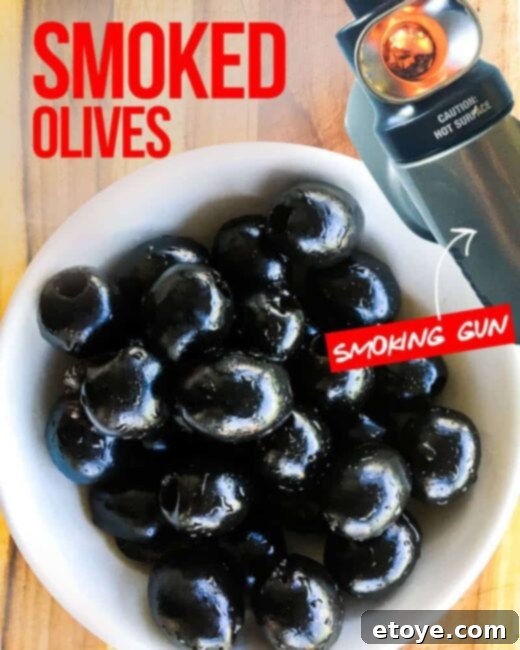Unlock Exquisite Flavor: The Art of Smoking California Ripe Olives

Just last month, I embarked on a culinary adventure to the picturesque Napa Valley in California, a region synonymous with gourmet delights and innovative food experiences. My mission? To delve deep into the world of those delightful, humble olives that once adorned my fingertips as a child, and to uncover the fascinating story behind their ingenious invention by a determined, widowed mother. This enlightening journey and post are proudly sponsored by the California Olive Committee, an organization dedicated to celebrating these remarkable fruits. Join me as we explore the surprising versatility of California Ripe Olives, especially when infused with a captivating smoky essence.
The Unexpected Delight of Smoked Olives: Elevate Your Culinary Creations
Imagine transforming a simple can of California Ripe Olives into a gourmet ingredient with depth and character. With just a portable hand-held smoker and a small pinch of aromatic wood shavings, you can craft Smoked Olives that will revolutionize your cheese platters, salads, homemade tapenades, cocktail garnishes, and even humble quesadillas. This innovative technique opens up a world of flavor possibilities, adding an irresistible, nuanced smokiness to a myriad of dishes.
My journey to this discovery began a few weeks prior when I received a thoughtful invitation from my dear friend and fellow food blogger, Elise, from the renowned Simply Recipes. She left a message inviting me to spend a couple of days in the heart of Napa Valley, California. The itinerary promised not only a chance to reconnect and enjoy a custom-crafted menu by Elise herself, but also an immersive experience dedicated to learning everything about California ripe olives. As an avid food enthusiast, the opportunity to combine friendship, exquisite cuisine, and culinary education in such a beautiful setting was simply too good to decline.

Pictured here: Elise, alongside Mike Silveira, a dedicated olive grower, and myself, soaking in the Napa experience.
Beyond the pleasure of savoring delightful meals and the excitement of experimenting in the state-of-the-art kitchen at the Culinary Institute of America (CIA), a highlight of our trip was learning the art of smoking olives directly from the esteemed Chef Paul Irving. Chef Irving’s expertise transformed the way I perceived and prepared olives. Following his demonstration, Elise ingeniously incorporated these freshly smoked olives into delectable Smoked Olive Quesadillas, showcasing their incredible versatility and how they can elevate everyday dishes into something truly special.

For many home cooks, the idea of smoking food can seem daunting, often associated with elaborate outdoor setups or a messy stovetop process. Indeed, attempting to smoke olives on a conventional stovetop can quickly turn your kitchen into a smoky chamber, leaving your drapes, walls, and even your pets smelling of smoke for days! Even in a professional setting like the CIA kitchen, equipped with powerful industrial hoods, the aroma of smoke lingered for hours. Thankfully, there’s a much more efficient, cleaner, and enjoyable way to achieve that sought-after smoky flavor.
Revolutionizing Home Smoking: Discovering the Smoking Gun
One of the most exciting and transformative tools to enter my kitchen recently is the Polyscience Smoking Gun. This ingenious device, typically available for around $99, allows you to effortlessly smoke virtually *anything* you desire, right in the comfort of your kitchen, without the lingering mess and odor of traditional methods. Its portable, battery-operated design makes it incredibly convenient and user-friendly, putting gourmet smoking techniques within reach of any home cook.
To operate the Smoking Gun, you’ll need specialized, small wood chips. It’s crucial to exercise caution and avoid purchasing wood chips from general home improvement stores. These chips are often treated or sprayed with harmful chemicals, making them unsafe for food consumption. Instead, opt for food-grade wood shavings specifically designed for culinary applications. You can either sustainably chop a few small branches from an untreated apple tree in your backyard (if you have one) or, more conveniently, source them from a gourmet specialty store or a dedicated BBQ supply shop. For my own smoking adventures, I purchased an excellent variety pack on Amazon, featuring 8 pints of Oak, Apple, Cherry, Pecan, Maple, Bourbon, Hickory, and Mesquite woods, each carefully selected for food smoking. This variety allows for experimentation with different flavor profiles, adding another layer of depth to your smoked creations.

A Quick Note on Wood Chips: Always look for fine wood shavings or very small chips. Larger wood chips designed for outdoor BBQ grills, such as these, are simply too large and coarse for the Smoking Gun’s small chamber and fine mesh filter.
The Polyscience Smoking Gun, often found in partnership with Breville, typically comes as a complete kit, making it easy for beginners to get started. My kit included handy recipe cards, two initial wood chip samples (Applewood for a sweet, mild smoke and Hickory for a classic, robust flavor), four batteries, and extra mesh screens for ongoing use. This comprehensive package ensures you have everything you need to begin your cold-smoking journey immediately.
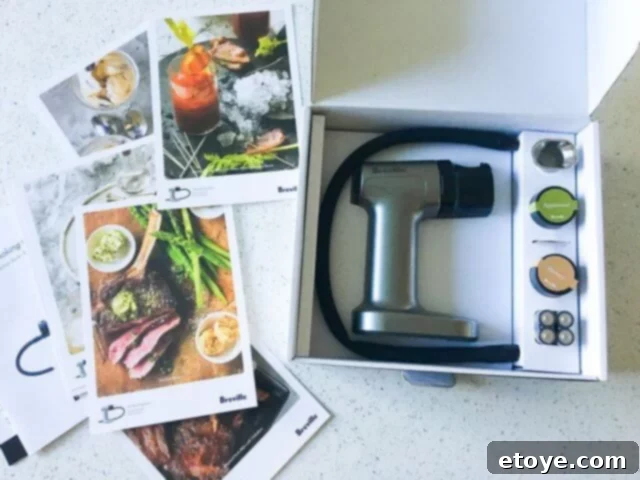
Mastering the Art: How to Smoke Olives with Your Smoking Gun
Before diving into the smoking process, let’s discuss the ideal type of olives to use. While this post is sponsored by the California Olive Committee, my recommendation for California Ripe Olives, readily available in cans at grocery stores nationwide, is genuinely based on their superior suitability for smoking. These olives are celebrated for their mild, buttery flavor profile and tender yet firm texture, which beautifully absorb and complement the smoky notes. Heavily pickled or brine-rich olives, on the other hand, tend to overwhelm the palate with their acidity and saltiness, making it difficult for the delicate nuances of the smoke to shine through. The subtle character of California Ripe Olives creates the perfect canvas for a truly balanced and delightful smoky infusion. We’ll explore more about the unique qualities of California Ripe Olives later in this article.
Now, let’s walk through the simple steps to smoking olives:
- Prepare Your Smoking Gun: Begin by adding a very small pinch of your chosen food-grade wood chips into the chamber of your Smoking Gun. Remember, less is often more when it comes to cold smoking, especially for delicate items like olives. Just a tiny amount is sufficient to create a flavorful smoke.
- Prepare the Olives: Drain your California Ripe Olives thoroughly. Place the drained olives into a sturdy, resealable plastic bag. Carefully seal the bag around the nozzle of the Smoking Gun, ensuring a tight seal to prevent smoke from escaping.
- Ignite the Chips: Turn the Smoking Gun on. Using a lighter or a culinary torch, gently ignite the wood chips in the chamber. The device will begin to draw air through the chips, producing a steady stream of cold smoke.
- Fill with Smoke: Within a mere two seconds, you’ll observe billows of fragrant smoke emerging from the nozzle and filling the bag. The rapid production of smoke is one of the key advantages of this handheld smoker.
- Seal the Flavor: Continue until the bag is sufficiently filled with lovely smoke. This usually takes just a few seconds.
- Infuse the Olives: Once the bag is full, turn off the Smoking Gun, carefully remove the nozzle, and quickly finish sealing the plastic bag to trap the smoke inside.
- Allow to Mingle: Let the cold smoke and olives sit together for a few minutes. Periodically, gently shake the bag a couple of times to ensure the smoke is evenly dispersed and infuses all the olives.

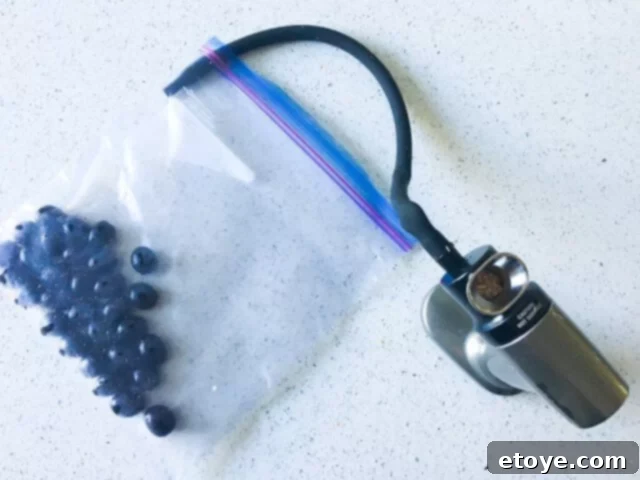
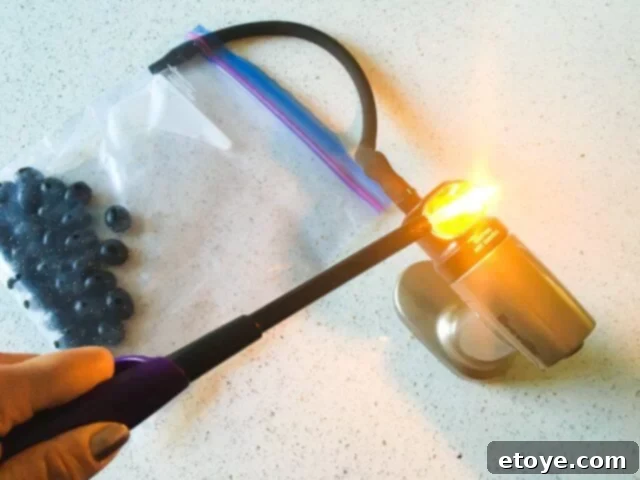
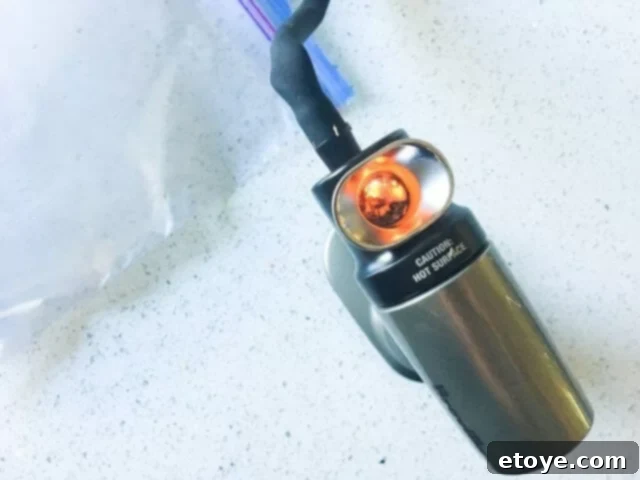

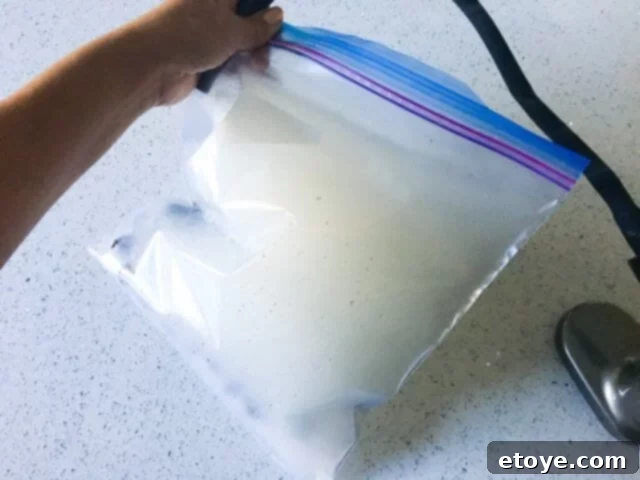
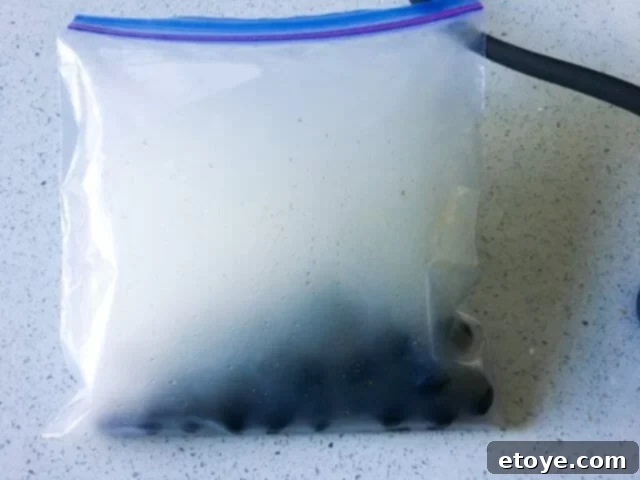
The duration you allow the olives to infuse in the smoke will directly impact the intensity of the flavor. A longer resting time will result in a more pronounced smokiness. While using the Smoking Gun produces a beautiful, subtle smokiness, it’s important to note that it won’t create the deeply intense flavor profile that Chef Paul Irving achieved in the CIA kitchen. Chef Irving employed a much larger quantity of wood chips, about a cup, and smoked the olives for approximately 30 minutes, creating a powerful, long-lasting smoke infusion. Our method, using just a pinch of wood chips and infusing for only a few minutes, delivers a delightful smoky olfactory experience with a transient smoky flavor, perfect for an evening’s enjoyment. However, for those desiring a more robust smokiness, you can easily intensify the flavor by repeating the smoking process with a fresh pinch of wood chips, allowing for multiple infusions.
Beyond Wood Chips: Exploring Tea for Smoking
For an even more innovative twist, consider experimenting with tea! Oooooh, the possibilities are even more exciting. Instead of traditional wood chips, I’ve had fantastic results smoking with just a pinch of black tea leaves. The tea imparts a different kind of aromatic complexity, adding intriguing, often subtle, floral or earthy notes to your olives. It’s a culinary hack that truly elevates the experience.
Once your olives are beautifully smoked, the culinary applications are endless. Use them to make a quick and vibrant tapenade, perfect for serving over grilled shrimp or fish. Incorporate them into a simple quesadilla for an unexpected gourmet touch. Their enhanced flavor also makes them an outstanding addition to charcuterie boards, antipasto platters, or even as a unique garnish for cocktails.
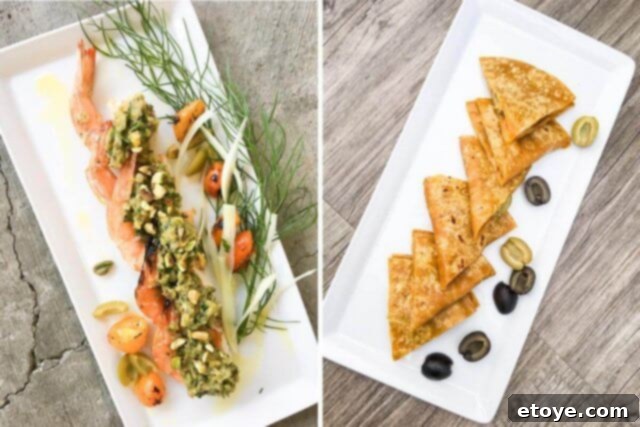
The Rich History and Unique Qualities of California Ripe Olives
Beyond their versatility, California Ripe Olives boast a fascinating history and distinct characteristics that set them apart. Understanding their origins adds another layer of appreciation to these culinary gems.
A Poor Widow’s Ingenuity: The Birth of an Industry
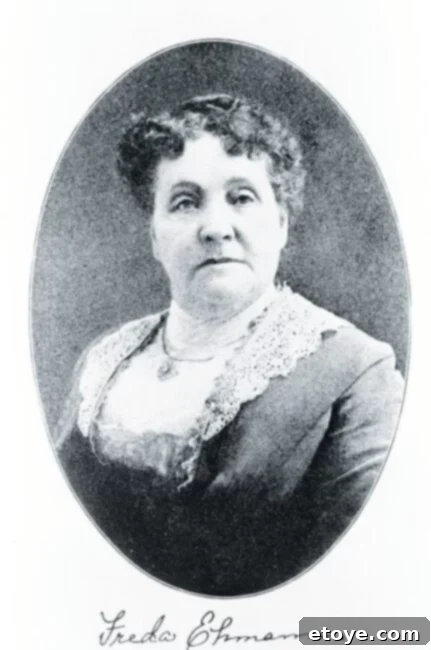 The story of California Ripe Olives traces back to the 18th century when Spanish missionaries first introduced olive trees to San Diego, California. They quickly discovered that the region’s unique climate – a perfect combination of abundant sunny days, refreshingly cool evenings, and crisp ocean air – provided an ideal environment for cultivating olives. This favorable climate led farmers to plant thousands of acres of olive groves, driven by the burgeoning demand for olive oil. However, as supply began to outpace demand, farmers soon faced a significant challenge: a glut of fresh olives that were highly perishable and spoiled rapidly.
The story of California Ripe Olives traces back to the 18th century when Spanish missionaries first introduced olive trees to San Diego, California. They quickly discovered that the region’s unique climate – a perfect combination of abundant sunny days, refreshingly cool evenings, and crisp ocean air – provided an ideal environment for cultivating olives. This favorable climate led farmers to plant thousands of acres of olive groves, driven by the burgeoning demand for olive oil. However, as supply began to outpace demand, farmers soon faced a significant challenge: a glut of fresh olives that were highly perishable and spoiled rapidly.
Among these struggling farmers was Freda Erhmann, a recently widowed, 56-year-old woman burdened by debt. She owned a 20-acre olive grove and, confronted with an abundant crop she couldn’t sell fast enough, Freda became determined to find an effective preservation solution for her fruit. Alongside her son, Edwin, Freda sought guidance from a state university professor, eventually developing a pioneering pickling method. With 280 gallons of olives and a strong will, they set to work in barrels, transforming a desperate situation into an innovative triumph.
Her dedication and ingenuity during this period are beautifully captured in historical accounts: “…she turned the back porch into a pickling plant, got some wine-casks, cut them in two, and went to work. Uncertain of the result, she dared not assume the expense of piping water to the vats, so that through all the process of leaching and pickling she carried the gallons of water herself. Passing restless nights, she went to work at five o’clock in the morning, and all through the day and until late in the evening she watched the slow and mysterious changes of the fruit. When at last she took a jar to the University she felt she had failed completely, because the olives showed every shade of green and brown and purplish black; and her surprise can hardly be imagined when the professor, having examined them, exclaimed, ‘They are the best ripe olives I have ever seen, and you are certainly an adept at pickling!’” (Source: Ancestry.com). This remarkable testament to Freda Erhmann’s perseverance highlights the birth of a method that is, to this day, still utilized by companies to preserve California Ripe Olives, a legacy of her incredible invention.
Unraveling Their Unique Texture and Taste
The olives cultivated for fruit in California are a distinct varietal from those primarily grown for pressing into olive oil. This difference is crucial to their unique appeal. California olives undergo a meticulous curing process to eliminate their natural bitterness. Following this, they proceed through several rinsing stages, some with and some without the introduction of bubbling air, to perfect their texture and color. Olives that are cured without oxygen retain their natural green hue, offering a vibrant counterpoint. Conversely, those olive tanks where oxygen is actively bubbled through the curing liquid will develop the iconic, glossy jet-black color that many associate with California Ripe Olives.
This specialized and unique curing process is precisely what bestows upon California Ripe Olives their signature firm yet smooth, buttery texture and exquisitely mild flavor. Unlike some intensely brined or heavily flavored olives, their gentle profile makes them incredibly versatile and palatable to a broad range of tastes.
I must confess, for many years, I didn’t give much thought to canned olives. In the past, I would simply grab whatever brand was on sale, chop them up for salads, or layer them into my go-to 5-Layer Cheese Dip. My olive consumption, while consistent, was rarely creative; they were always just an ingredient. However, this transformative trip to Napa, particularly my time at the famous Culinary Institute of America, completely reshaped my perspective. It was there that I truly had the opportunity to savor California ripe olives on their own, discovering their mild, buttery, and incredibly smooth taste as a standalone delight.
The ironic truth is, I had anticipated that the highlight of the trip would be exploring all the wonderful and inventive ways to cook with olives. And while we certainly did that, by far my most cherished discovery was the realization that California ripe olives are absolutely perfect exactly as they are. Throughout my two days in Napa, I found myself instinctively reaching for them whenever a bowl was placed before me, snacking on them one after another, completely captivated by their simple yet profound deliciousness.

Our time at the CIA kitchen also provided a fantastic opportunity to unleash our inner chefs. Here I am pictured with Nik from A Brown Table, Dara from Cookin’ Canuck, and Serena from Serena Bakes Simply From Scratch. Together, we collaborated to create the exquisite Grilled Shrimp with Olive Fennel Tapenade, a dish you can see beautifully captured in the photo above. To learn more about the incredible world of California Ripe Olives, visit their official site, and connect with their vibrant community on Facebook for more recipes and inspiration.
Thank You for Supporting Our Culinary Journey!
Your support means the world to our small family business, Steamy Kitchen. Even if you don’t purchase the specific products showcased, simply beginning your Amazon shopping here helps us immensely. We receive a small commission from Amazon, which plays a crucial role in keeping this site running and providing free, delicious content for all our readers!
